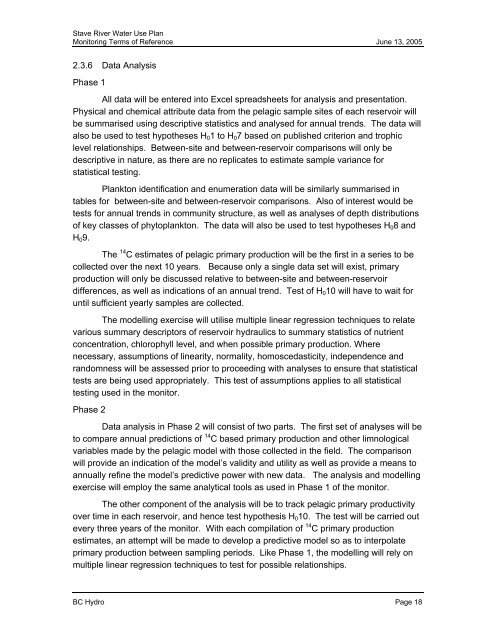Stave River Water Use Plan - BC Hydro
Stave River Water Use Plan - BC Hydro
Stave River Water Use Plan - BC Hydro
You also want an ePaper? Increase the reach of your titles
YUMPU automatically turns print PDFs into web optimized ePapers that Google loves.
<strong>Stave</strong> <strong>River</strong> <strong>Water</strong> <strong>Use</strong> <strong>Plan</strong><br />
Monitoring Terms of Reference June 13, 2005<br />
2.3.6 Data Analysis<br />
Phase 1<br />
All data will be entered into Excel spreadsheets for analysis and presentation.<br />
Physical and chemical attribute data from the pelagic sample sites of each reservoir will<br />
be summarised using descriptive statistics and analysed for annual trends. The data will<br />
also be used to test hypotheses H01 to H07 based on published criterion and trophic<br />
level relationships. Between-site and between-reservoir comparisons will only be<br />
descriptive in nature, as there are no replicates to estimate sample variance for<br />
statistical testing.<br />
<strong>Plan</strong>kton identification and enumeration data will be similarly summarised in<br />
tables for between-site and between-reservoir comparisons. Also of interest would be<br />
tests for annual trends in community structure, as well as analyses of depth distributions<br />
of key classes of phytoplankton. The data will also be used to test hypotheses H08 and<br />
H09.<br />
The 14 C estimates of pelagic primary production will be the first in a series to be<br />
collected over the next 10 years. Because only a single data set will exist, primary<br />
production will only be discussed relative to between-site and between-reservoir<br />
differences, as well as indications of an annual trend. Test of H010 will have to wait for<br />
until sufficient yearly samples are collected.<br />
The modelling exercise will utilise multiple linear regression techniques to relate<br />
various summary descriptors of reservoir hydraulics to summary statistics of nutrient<br />
concentration, chlorophyll level, and when possible primary production. Where<br />
necessary, assumptions of linearity, normality, homoscedasticity, independence and<br />
randomness will be assessed prior to proceeding with analyses to ensure that statistical<br />
tests are being used appropriately. This test of assumptions applies to all statistical<br />
testing used in the monitor.<br />
Phase 2<br />
Data analysis in Phase 2 will consist of two parts. The first set of analyses will be<br />
to compare annual predictions of 14 C based primary production and other limnological<br />
variables made by the pelagic model with those collected in the field. The comparison<br />
will provide an indication of the model’s validity and utility as well as provide a means to<br />
annually refine the model’s predictive power with new data. The analysis and modelling<br />
exercise will employ the same analytical tools as used in Phase 1 of the monitor.<br />
The other component of the analysis will be to track pelagic primary productivity<br />
over time in each reservoir, and hence test hypothesis H010. The test will be carried out<br />
every three years of the monitor. With each compilation of 14 C primary production<br />
estimates, an attempt will be made to develop a predictive model so as to interpolate<br />
primary production between sampling periods. Like Phase 1, the modelling will rely on<br />
multiple linear regression techniques to test for possible relationships.<br />
<strong>BC</strong> <strong>Hydro</strong> Page 18
















